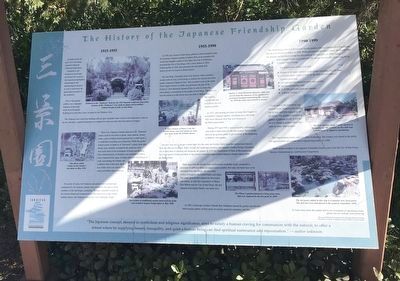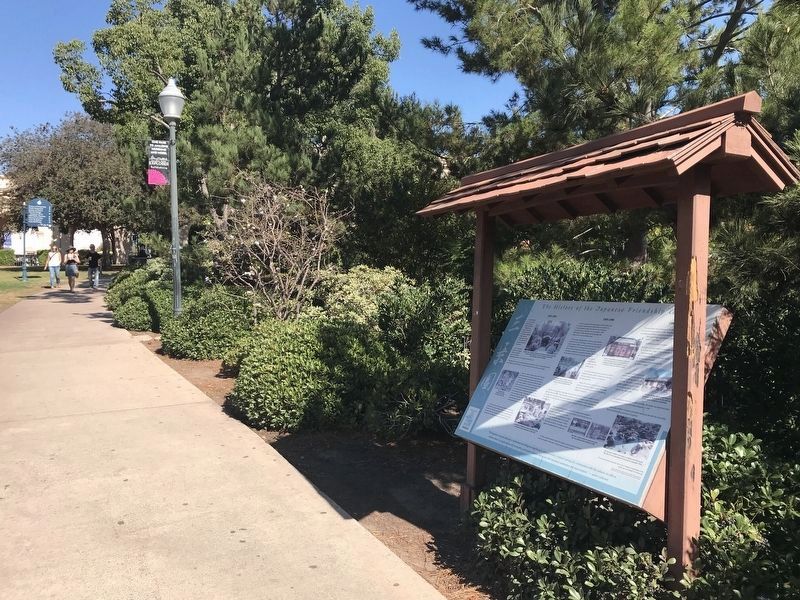San Diego in San Diego County, California — The American West (Pacific Coastal)
The History of the Japanese Friendship Garden
1915 - 1955
In Balboa Park the year 1915, San Diego opened its Panama-California Exposition. Designed to call attention to San Diego and bolster the economy, the Exposition highlighted archaeological and anthropological displays as well as advertised the agricultural potential of the southwest.
One of the popular exhibits was a Japanese "Teahouse" built just north of the Botanical Building in an area that is now occupied by the Children's Zoo.
The Teahouse was a one-story building with an open veranda where visitors to the Exposition could sit, sip tea, and enjoy a garden landscaped in a manner few had seen other than from photos of Japan.
There was a Japanese Garden adjacent to the "Teahouse" which could be described as plants, stone lanterns, bronze cranes, and a winding stream squeezed into a small space so small that everything was foreground. While the garden lacked a sense of depth or borrowing of scenery ("shakkei"), details were carefully executed by the gardeners who were well versed in the techniques of bonsai and ikebana. The overall harmony of elements was sacrificed as effects were compressed for space. In Japan there are often fences or walls surrounding the Garden, but in Balboa Park at that time, there was neither fence nor wall to help create and define areas or moods.
For nearly 30 years, the Teahouse and garden were operated and maintained by the Asakawa family, who continue to this day as active members of the San Diego community. Though a symbol of the strong cultural and commercial ties that linked the two nations, the Teahouse and garden were eventually closed.
1955–1990
In 1955, key citizens of San Diego gathered, and formulated a plan for restoring a Japanese garden in Balboa Park on an expanded site. As the first tangible symbol of this effort, the City of Yokohama presented the City of San Diego with a snow lantern in 1956. Following that in 1958, they presented the Friendship Bell, which can now be found on Shelter Island.
The San Diego Yokohama Sister City Society, whose members worked with the City of San Diego to identify the current site of the garden, acquired a Japanese Gate. They installed it just to the north of the Organ Pavilion. In. 1968, they dedicated the gate as the Charles C. Dail Memorial Japanese Gate in order to honor the commitment by the people of San Diego. The gate was near the entrance to the 11 acres set aside in Balboa Park.
In 1977, after hearing the plans by many San Diegans to reestablish a Japanese garden, Yokohama gave San Diego 100 cherry blossom trees that now blossom at the Wild Animal Park.
During 1977 and 1978, a series of public conferences were held to make plans for the new garden. These events allowed the general public to get involved in the designing of Balboa's new garden.
The next step was to design a master plan. For this task, the Society called upon the architectural firm of Fong & LaRocca Associates. Takeo Uesugi, the Landscape Architect and Japanese Garden Design Consultant, was to help them in planning and designing the garden. In 1979 the Department of Parks & Recreation and the City Council's Public Facilities & Recreation Committee approved the Japanese Garden Master Plan for Balboa Park. The Society had a professional feasibility study completed to determine if sufficient financial support was available. Not only did funds have to be identified from San Diego, but also from a sources throughout the United States and Japan. The study showed that support for the project was strong, so with the cooperation of Mayor Pete Wilson and the City of San Diego, the new Japanese Friendship Garden was under way.
In 1985, Landscape Architect Takeshi Ken Nakajima named the garden San-Kei-En, which means garden of three types of scenery—pastoral, mountain, and lake.
1990–1999
The initial Master Plan was designed so that garden could be constructed in five phases, with the first opening in August 1990. While planning for the second phase, the Master Plan was changed and the phase system was discontinued. In September 1999 a major Improvement Project was 'completed. The design team for this project was led by landscape architect Professor Takeo Uesugi.
The Improvement Project included:
Plaza at the upper entrance of the garden including a Tea Pavilion. Garden Study Center to focus on the skill and techniques of Japanese gardening. Expanded and enhanced entire upper garden. Expanded garden staff. 10,700 gallon koi pond and waterfall. Bonsai Garden.
The improvement project took two years of planning. The Garden was closed to the public for approximately six months and re-opened September 21, 1999.
Erected by San Diego Japanese Friendship Garden.
Topics. This historical marker is listed in these topic lists: Asian Americans • Horticulture & Forestry • Parks & Recreational Areas • Peace. A significant historical month for this entry is August 1990.
Location. 32° 43.824′ N, 117° 9.009′ W. Marker is in San Diego, California, in San Diego County. Marker is on Pan American Rd E, on the right when traveling north. Touch for map. Marker is in this post office area: San Diego CA 92101, United States of America. Touch for directions.
Other nearby markers. At least 8 other markers are within walking distance of this marker. House of Charm (about 300 feet away, measured in a direct line); Spreckels Organ and Pavilion (about 400 feet away); First Declaration of Human Rights by Cyrus the Great (about 600 feet away); Laguna de Las Flores (about 700 feet away); California Quadrangle (about 700 feet away); Casa del Prado (about 700 feet away); Zoro Gardens Nudist Colony (about 700 feet away); The Botanical Building (about 700 feet away). Touch for a list and map of all markers in San Diego.
Credits. This page was last revised on October 26, 2023. It was originally submitted on November 2, 2022, by Adam Margolis of Mission Viejo, California. This page has been viewed 298 times since then and 117 times this year. Photos: 1, 2. submitted on November 2, 2022, by Adam Margolis of Mission Viejo, California. • Bill Pfingsten was the editor who published this page.

